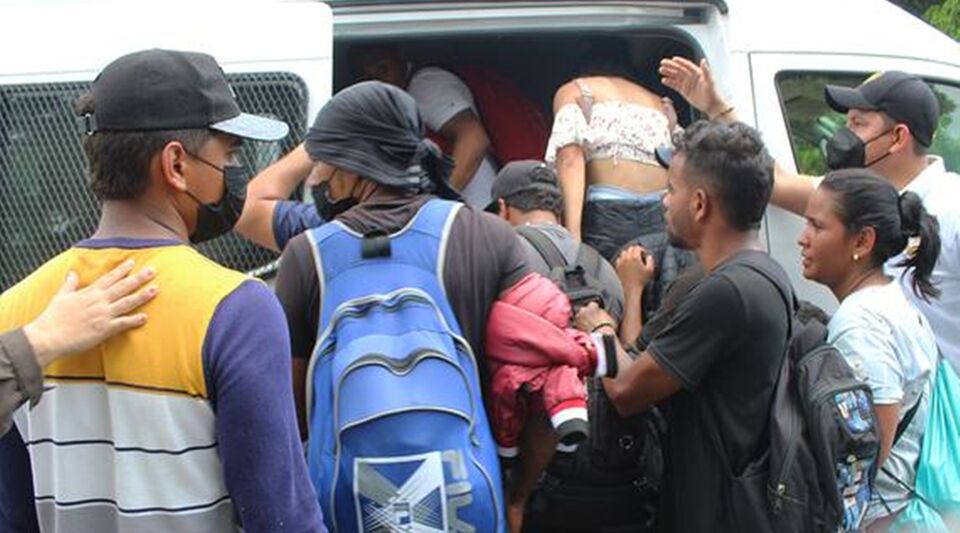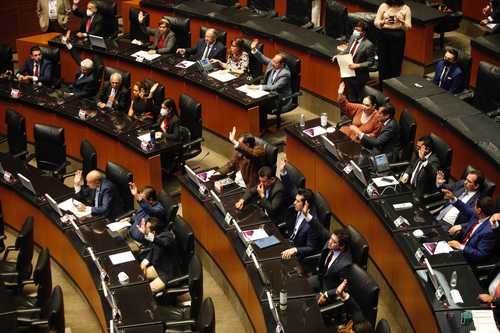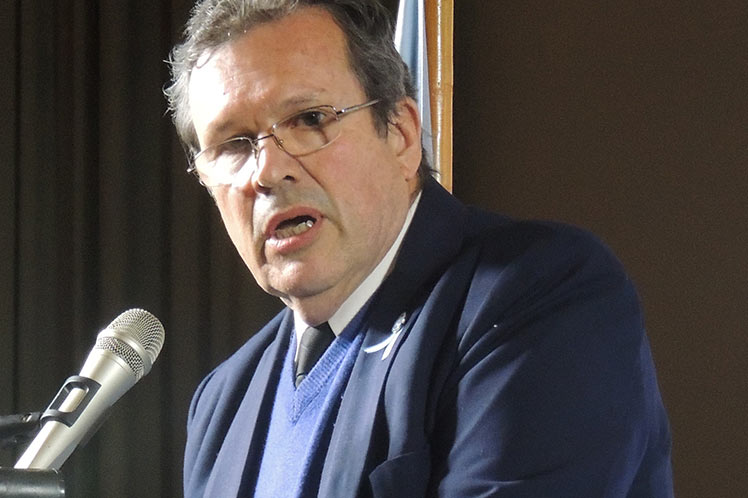Three hours into the trip, on the way to Monterrey, I had cramps in my buttocks. Imagine eleven more hours. Luckily I had a paracetamol and the pain was relieved, but after a few hours it was back again. I asked them to please let me stretch out my foot but I couldn’t: we didn’t fit.
There I learned a very interesting story. There was a Nicaraguan who worked in a restaurant in Managua, where President Daniel Ortega and Rosario Murillo love to eat. Although he did not like what the leaders were doing in the country, he was very happy when they went to dinner, because they left each one a 100 dollar tip, which, according to what he told me, was sometimes 14 or 16. Until Once a week the Ortegas go to that place, the Nicaraguan assured me, and he told me that when Díaz-Canel was there, for the inauguration, they called them to close the place, because he was going to go with Ortega, although at In the end they changed and went somewhere else.
This was also one of those who did not run away from the political situation. Only one of those I met did it for these reasons, they all went to collect money and then return.
Halfway down the road they dropped us off at a gas station and put us back in combis. We spent an hour waiting for some checkpoints to go through where we had to pass and, from there, we went to a small desert town, with a sun so strong that it burned you, although it was not the heat of Cuba.
There they put us in a warehouse that had a swimming pool, a fifth, they call those rural houses in Mexico. They had divided us into two groups: we were going to Monterrey and the rest to another place. Then a woman told us: “Look, please, those who have what to bathe in the pool, change and bathe, and the others who stay around here. Let’s put on a little music. In case someone comes inspection, you guys rented this and are celebrating a birthday.
Those who took a bath had a nice day, but in the end it was all normal, because they told us that the tap water could not be drunk, so we could not drink until, around three in the afternoon, they showed up with two bottles of water of 5 liters each, but we were more than 60! Then they brought two tacos per person and some weird beans, with a little bit of meat, but it was terrible. I looked at him and said: “Well, I have to eat it, nobody knows how long we will be here and if they will bring us food again.” Luckily, because we were there all day, all night and almost all morning. The vans that had to pick us up at 10 o’clock had to go to the other place, because half of them had been put in a container and they didn’t want to go because they were drowning. They started hitting and hitting and, luckily, the driver stopped and about 20 or 25 got out: that they had paid thousands of dollars and they didn’t have to go there, where they were drowning.
“Others stay around here. Let’s put on some music. In case any inspections come, you guys rented this and are celebrating a birthday.”
In the end the combis appeared where we were at 5 in the morning. Only the women and children were inside the little house on the fifth, the men had to sleep outside for a bit. In the desert it is terribly sunny during the day, but at night three times worse.
The vans, thank God, did have heating and we were able to take off our coats a bit. We spent many hours, because several controls had to be evaded, and the trip that was supposed to take five hours took us about eight.
Upon arrival in Monterrey, we waited in a place in the city for some taxis, in which they divided us up to finally board a closed truck with openings in the roof in another place. We were 42 people there, who were already together until the end. I was the only Cuban, the others were Hondurans, Nicaraguans and Guatemalans. On the way there was a warehouse where we were locked up for a day and a half, where it was also very cold and the conditions were bad. The mats were not enough for everyone and we squeezed in as best we could.
At least they did bring us good food, and the things they sold us were cheaper than in Mexico City. However, I had another anxiety crisis, because everything was closed, and when I called my family, I exploded: “This can’t be it. I don’t understand what’s happening, they didn’t tell me it was like that.” They always paint everything in pink, that’s the hook, and, despite everything, I can’t complain, because there are people who have a worse time.
From there they took us to a small field where there were three or four trucks, in which we already knew there were people, although not how many. We got the biggest one, one like the ones used in Cuba to load cane, with high railings at the back. When we got on, there were already almost 200 people there. We were all pressed as tight as possible, without the possibility of holding on. It was a short but hard trip. There were several people who injured their ankle, including me, although nothing that prevented me from continuing.
At 12 at night we arrived at a point near Reynosa where we stopped, because there was a checkpoint with seven patrols. Apparently a truck like ours had overturned, for trafficking undocumented immigrants. They allowed us to get out of the truck, there at zero degrees, but we were able to smoke and eat some cookies, until at 3 or 4 in the morning we could continue.
Then we got to another place where we were divided into two groups. Each of us had a code that they gave us in Monterrey, which the cartels assign to you, and it is the one that you have to give to the cartel so that they let you continue or take you to the border. We were many, many, several trucks. There would be more than 400 people, because I was 367. We looked like merchandise.
We were picked up at that warehouse at 42, in two vans. That was the last warehouse before crossing, the one in Reynosa. In it I met a Honduran who had been waiting three months for a supposed special trip, because he was lame, but his son, who was in the US and was paying for everything, they took him and returned him to Honduras. The guy had been there for three months, waiting for his son to collect money again, because he couldn’t go around like the others to avoid controls.
It was terribly cold in that place too, although the coyote He treated me very well. They were not used to a Cuban and they asked me many things, they gave me different treatment for being from the Island. We stayed there three or four days. The conditions were not the best, the food was not the best, but at least we were calm after so much travel.
When they came for us, they separated us into lists: the Cubans, the Nicaraguans, and the women and children, one from El Salvador and the others from Honduras. They give themselves up because they are not returned: if they go with small children they let them pass. The Hondurans and Guatemalans had to stay and wait for another list to make their rodeo. They cross and begin to circle to escape the migration guards; quite the opposite of what we do, those of us who deliver. We cross and we have to look for the guards to turn ourselves in, so they can take us prisoner.
When they came for us, they separated us into lists: the Cubans, the Nicaraguans, and the women and children, one from El Salvador and the others from Honduras.
On the fourth day it was my group’s turn. They came for us in a van, we were nine adults and two children, and they took us to a place very close to the Rio Grande. They passed us through a filter with a person who gave us some numbered blue bracelets that said: “delivery”. For every migrant who crosses, the coyote he has to pay the cartel, and there is a lot of control with that, because sometimes they try to pay less, which has led to many deaths. That’s why now they do it like this, all square: person for money.
I was lucky there, because a few days ago I was able to talk to my barber in Havana, who now lives in the US, and I noticed it was very strange. This is not the David I know, I thought. The point is that he crossed through Piedras Negras, Coahuila, and there were 120 people there, at 3 in the morning. He says that they threw a small raft for the children and a rope from one side to the other. That’s where adults had to go. The deepest part of the cold covered his nose, which is about 1.67. He was helping a girl who, at one point, became very nervous, but she was holding on well to the bottom and they managed to cross about 70 meters of river. In front of them came a Nicaraguan woman who began to say: “I’m drowning, I’m drowning”… And before they could see her she was gone. She disappeared.
It was like a trauma for him, because at that moment his legs did not respond, he could not cross, he lost consciousness. Luckily, the migrates he picked him up and wrapped him in blankets, but told me he thought he was going to die. He took less time on his journey than me, but he was less safe: they took him prisoner in Honduras, they had an accident on a bus, then this last one from the river… All quite ugly.
They then made us hide in a bush and wait for them to come and tell us.
morning
They put 15 of us on our knees on a raft to cross the Rio Grande
________________________
Collaborate with our work:
The team of 14ymedio is committed to doing serious journalism that reflects the reality of deep Cuba. Thank you for joining us on this long road. We invite you to continue supporting us, but this time becoming a member of our newspaper. Together we can continue transforming journalism in Cuba.








